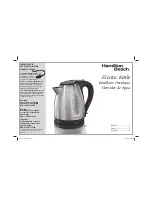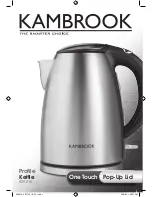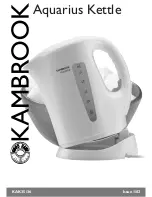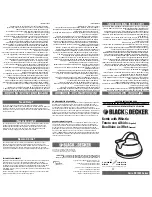
8
MAINTENANCE
Cleaning the Kettle
The most important preventive maintenance opera-
tion on the steam jacketed kettle is the daily cleaning
procedure after each use.
All kettle cleaning procedures should be faithfully com-
pleted by the end of each day’s operation. In addition,
cabinet doors, top, fixtues, kettle lid, etc., should be
washed and rinsed to remove all food spills.
1. Fill kettle with water and mild detergent immediately
after removing food from kettle.
2. Scrub kettle interior with a nylon brush.
NOTE: NEVER SCRAPE KETTLE INTERIOR WITH
METAL TOOLS, STEEL SCOURING PADS
OR ABRASIVE CLEANERS. Scratches will
result, which will ruin the kettles general ap-
pearance and make it harder to clean and
maintain in a sanitary condition.
3. Loosen food which is stuck to kettle by allowing it to
soak. Also, a small amount of steam may help.
4.
Position swing drain under draw-off valve. Open
draw-off valve to drain soapy water.
5. Wipe down exterior, rinse and dry. Avoid getting water
into electrical controls.
WARNING
DO NOT HOSE DOWN UNIT AS IT MAY CON-
TAIN ELECTRICAL COMPONENTS.
6. Remove strainer from inside kettle. Wash and rinse
thoroughly.
7.
Disassemble draw-off valve by first turning valve
handle counterclockwise. Then, turn hex nut counter-
clockwise until valve handle and stem are free.
Large Nut
Figure 4
8.
Wash inside of draw-off valve with a nylon brush.
Figure 5
9. Rinse kettle valve interior and reassemble valve.
NOTE: Leave draw-off valve open when kettle is not
in use.
10. Remove swivel drain and its strainer. Wash, rinse and
replace.
Weekly Cleaning
In addition to the daily cleaning it is necessary to clean
the air intakes on a weekly basis. Air intakes provide nec-
essary cooling air to the internal components. They are
generally located on the rear and sides of the equipment.
Tilting Mechanism Lubrication
Lubrication of the tilting mechanism is the only required
preventive maintenance other than daily cleaning.
1. Inspect the screw of the tilting mechanism annually
for adequate lubrication.
2. If screw appears “dry”, apply good grade bearing
grease directly on the threads so that the threads ap-
pear to be barely damp.




























